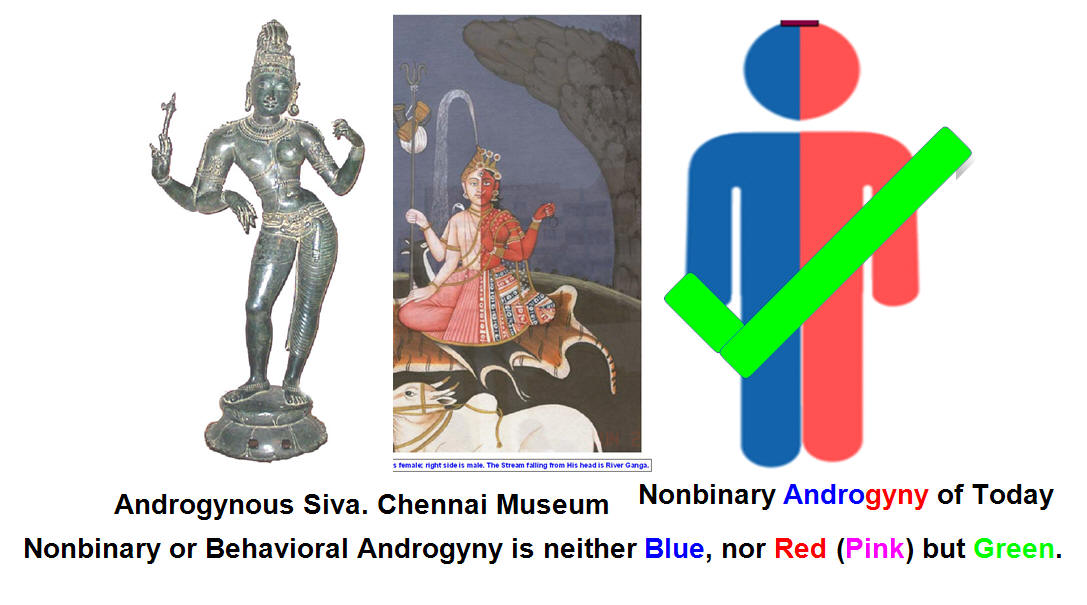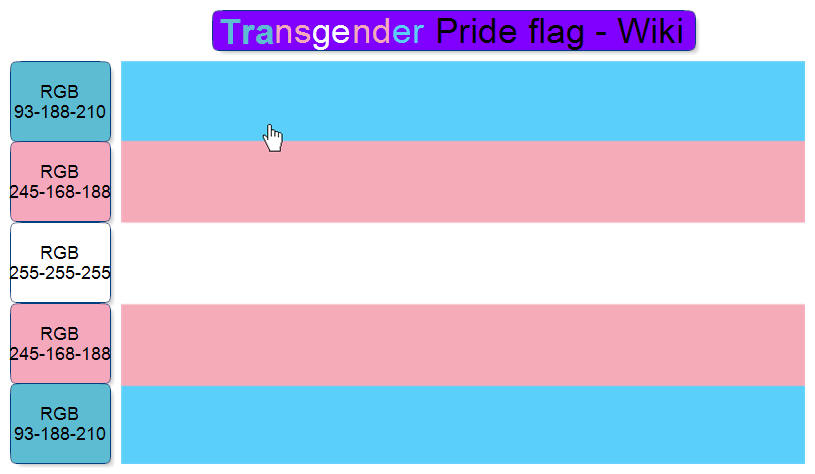Behavioral Androgyny
Veeraswamy Krishnaraj, M.D
In olden days, I learned from Hindu religious texts there were three entities in the world: He, She and It. Then one day, Ardhanarisvara entered my consciousness. It was the androgynous Siva. His left half is Sakthi and the right side is Siva.

Androgynous Siva
Father is the Creator, and Mother is the Liberator from the world of miseries. Androgynous Siva-Sakti (Chennai Museum) has the right half for male and left half for female; the former is the creative Purusa Sakti, while the latter is the liberating sakti; Purusa is Daksina (right) and Sakti is Vama (left). As long as the androgynous form endures, Sakti and Siva are in balance, Samsara (life on earth) plays its havoc on Jiva (we the people), and liberation is in abeyance. When the Sadhaka by his intense Sadhana (spiritual effort) awakens the liberating left side (Sakti half) and renders it more powerful than the creative Purusa right side, Devi in her new-found power gleefully encroaches on the right side, fills it with her liberating power, and confers liberation to Jiva. This transformation earns her the name Daksina Kali, the liberator and savior of the three worlds. The androgynous form is fully transformed into Sakti form, until a round of creation comes into force and the androgynous form makes a comeback. This Daksina form is a reversal of Isvari to its neutral form, Brahman, who is free of gunas, creative, preservative and destructive qualities. Daksina-Brahma form transforms into Isvara with Maya and gunas; a galaxy of gods, goddesses, men and beings, and matter issue forth from her. All gods and goddesses are equal in the eye of Devi; any sectarian attempts to claim superiority of one god or goddess over another is against Saktitattva. A good Sadhaka is one who recognizes that Adhisakti (Adyasakti, ancient primordial Sakti) encompasses Vishnu, Siva, Surya, and Ganesa Saktis. Bhagavan speaks of himself as written in Tantra Sastra, " Brahman, Sakti, and Mahesvara: these three are the same; the only difference among them is that Brahman is neuter, Sakti is feminine, and Mahesvara is masculine. In the highest consideration, all are same, but the descriptive words are different." An actor portraying a character has no direct connection with that character; in like manner Bhagavan has no connection with the form he represents. But that portrayal of a form has meaning to the Jiva (we the people, the audience, the spectator). Siva and Sakti assume the gender-specific forms to please the Sadhaka; once the Sadhaka attains siddhi meditating on these forms, Nirguna neuter Brahman reveals itself to the Sadhaka. Sadhaka may want to imagine her in his mind in the form of Durga, Kali, Krishna, Lakshmi, Radha, Rama, Siva, Sita, Tara, Vishnu, father, mother, or Guru (the Lord); A Vaishnava needs to exercise no compulsion to consider Devi as Vishnu. Sakta needs no pressure to regard Devi as Sakti. When we delve deep into meditation and enter the realm of Citsakti, all differences in form and gender evaporate, and Kalisakti, Sivasakti, Krishnasakti, and all other saktis lose their individual identity and merge into one sakti because of sloshing waves in the ocean of citsakti. Mahasakti forms the hypostasis of all five forms, Siva, Vishnu, Durga, Ganesa, and Surya and offers liberation. He who realizes that unity in five forms knows Sakti tattva.
Ramakrishna Paramahamsa comments on Ardhanarisvara.
No one can say what Sachchidananda (Sat-Cit-Ananda = Being-Consciousness-Bliss) is like. That is why He first took the form of Ardhanarisvara (half man and half woman). Do you know why He did so? It is to show that both Prakriti and Purusha are Himself. At a step still lower, Sachchidananda became several Purushas and Prakritis.
The modern (Behavioral) Androgyny among teenagers is a feeling and spurns the DNA and the body habitus. In the male-dominated society, teenagers found expression of their liberation from stereotyping of their gender roles. The body remains the same, but the mind, the soul, and the speech changed. Everything is intended to minimize and erase gender portrayal and present nonbinary freedom and spirit.
In the last several years, teenagers have exercised their constitutional right to feel, say, look, and dress the way they like. They walked away from the pink and the blue and have embraced the Green. Gender identifiers in language have also changed. The boxy look of the green clothes is in, and tight fits are out, I presume, deliberate obfuscation of gender landmarks.
Definitions.
Transsexual:
1. a person having a strong desire to assume the physical characteristics and gender role of the opposite sex.
2. a person who has undergone hormone treatment and surgery to attain the physical characteristics of the opposite sex.
Cisgender relates specifically to gender rather than sexuality. A person can be cisgender (often abbreviated to just cis) and have any sort of sexuality. For example, two men may both be cisgender but one straight and one gay.
Gender bender: —gender-bending, adj. Informal. One, as a cross-dresser, that blurs differences between the sexes.
Gender binary is the classification of gender into two distinct, opposite, and disconnected forms of masculine and feminine, whether by the social system or cultural belief (DNA reveals their genetic sex.)
Non-binary is a spectrum of gender identities that are not exclusively masculine or exclusively feminine—identities that are outside the gender binary.
“Androgynous fashion isn’t only about looking boxy, and flow and looking ambiguous,” they said. “The androgynous fashion movement is about expressing yourself without the confines of gender.” NYT
In 2017, a University of California, Los Angeles study found that 27 percent (796,000) of California youth between the ages of 12-17 believed they were seen by others as gender nonconforming. NYT
Some progressive synagogues and Jewish communities are holding nonbinary mitzvahs. Nonbinary teenagers are choosing non-gendered for driver’s licenses. NYT

RGB = Red-Green-Blue mix of colors.
Androgynous architectural looks: She is known for wearing baggy, oversized clothing, and on the red carpet wears gigantic jackets and big furry pants. On stage, she is often seen wearing hoodies, large athletic-looking shorts, and tube socks. NYT
Nonbinary teenagers sport androgynous look: Over-sized clothes, over-sized buttoned shirts, chains, suits, scarves and fedora hats. NYT
Nonbinary persons have a Gender-Neutral Prefix "Mx." NYT
The androgynous fashion: Boxy clothes and looking ambiguous with no reference to genotype or phenotype (DNA or appearance). NYT
Pediatric Journal USA
Pediatrician’s CONCLUSIONS: Health care utilization differs between TGNC versus cisgender youth and across gender presentations within TGNC youth. With our results, we suggest that health care providers should screen for health risks and identify barriers to care for TGNC youth while promoting and bolstering wellness within this community. Pediatrics-AAP
Abbreviations: TGNC — transgender and gender nonconforming.
Behavioral Androgyny: Teenagers of either gender (adolescents or boys and girls in everyday language) efface their primary and secondary sexual body parts by wearing boxy clothes, neither blue nor pink - a telltale assigned color of genders. Other items worn are metal chains, hats, boots... You may identify them by gender-specific voice. This is not anatomical or genetic androgyny.
https://www.nytimes.com/2019/08/14/style/nonbinary.html